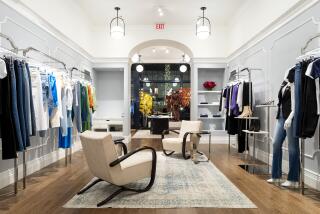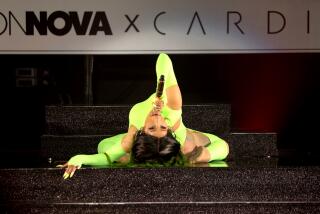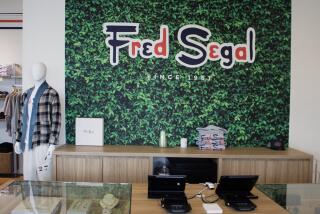Clothing Makers Take Greater Retail Control
The unusual concrete structure on the corner of La Cienega and Santa Monica boulevards bears a simple red and white âEspritâ sign. Passers-by peer curiously into its windows while drivers do double takes as they cruise by.
Is it an office building, a restaurant or a store?
From the outside, itâs difficult to tell. But inside, Esprit is clearly a clothing store, although not an ordinary one.
Shoppers can be found piling clothes into grocery carts or baskets and paying for their purchases at a bank of five checkout counters that resemble those at a supermarket. The vast, airy 15,000-square-foot selling space, which opened âunofficiallyâ and without fanfare over Thanksgiving weekend, contrasts sharply with the crammed look that most stores have these days. More important, it is the only store in the country stocked entirely with the Esprit line, one of the hottest sportswear looks.
The bold and innovative merchandising format represents a costly experiment by San Francisco-based Esprit de Corp., one of the growing number of U.S. manufacturers of name-brand apparel that are attempting to sell their own products in their own way.
Often frustrated by the almost careless display of their products at stores, many manufacturers like Esprit are assuming greater control over retail presentation of their brands.
The Los Angeles store is the first of several that Esprit plans to open in the United States. The privately held company already has stores in Hong Kong, Kowloon, Sydney and Melbourne and operates a factory outlet store in the San Francisco area. It plans to open a 16,000-square-foot store in New Orleans in a few weeks and a 20,000-square-foot store in New Yorkâs Soho by 1986. Stores are also planned for Dallas, Washington and Boston.
âWe think we need these flagship stores to make a public statement about our products and put our image out there,â explained Doug Tompkins, 41, president and chief executive of Esprit, which he founded and owns with his designer wife, Susie, 42.
Tompkins points out that European designers for years have opened their own boutiques in the United States. âThis is not some revolutionary idea,â he said.
In addition to the stores, Esprit recently began opening boutiques within major department stores such as Bullockâs, Bloomingaleâs, Macyâs, Marshall Field and other chains across the country. Similarly, there are 37 Polo/Ralph Lauren shops in the United States, with 13 more slated to open by year-end, including the first free-standing store in Manhattan to be directly owned by Lauren and Polo Fashions Inc. Welsh designer Laura Ashley has 50 free-standing U.S. shops as well as in-store boutiques at Bullockâs stores in Pasadena and Westwood.
Last Friday, the first free-standing Merona Store, offering only Merona brand clothing and accessories for men, women and children, opened at Pebble Beach. The store is owned and operated by Pebble Beach Corp., but Georgiana Castle, a spokeswoman for the Merona division of Oxford Industries Inc., said: âIt is a pilot project in terms of looking into housing all our collections under one roof.â
Frank Doroff, senior vice president and merchandise manager for ready-to-wear and accessories at Bullockâs, noted: âIt used to be manufacturers sold products to a store, then it was over, their involvement ended. Now, they are getting involved in how their merchandise is sold and presented. It is something the cosmetics industry has been doing for years.â
Tompkins says Esprit has cut back on the number of stores to which it distributes--to 2,100 from 4,000--and eventually plans to reduce that to 1,000. âWeâre still in many stores we donât like at all,â Tompkins said. âMany stores have what I consider low standards of presentation and service. It doesnât enhance our image to be in them.â
Full Presentation
Tompkins maintains that retailers donât place a high premium on âniceâ presentations to the consumer. âThey donât care to accessorize and make pleasant displays in general. Thatâs not always the case, but there is no place for a full presentation of our full collection. They (stores) all take bits and pieces. We want to make full presentation (of our lines).â
The Esprit store provides an extensive selection of coordinated casual clothing, shoes and accessories for women and children at prices that range from $6 for a pair of socks to $150 for a linen coat. The store is still about three weeks from completion, and workmen can be found among Espritâs salespeople, recognizable in their oversized shirts with Esprit logos.
Tompkins said the store, which was originally scheduled to open in July, is âway over budgetâ at $12 million, nearly double the $6.5 million to $7 million the store was expected to cost. Tompkins bought the old Flippers roller skating rink and had it redesigned by architect Joe DâUrso, who included plans for an adjacent parking lot.
âAfter about 12 months of construction, one day you have to open whether ready or not,â Tompkins said, adding: âIt is operating amazingly well.â Esprit sent out notices about the opening to 40,000 of its mail-order customers in the area. Otherwise, he says, business has resulted from word of mouth.
Sales during the storeâs first four weeks totaled $750,000, according to Tompkins, but he added that those weeks âhappened to fall at Christmastime. . . . We would like to get $10 million this year and are forecasting to do $18 million in 1986.â
Tompkins is projecting total company sales for the year ending this June at $800 million, of which U.S. sales will account for about $375 million. Espritâs own retail and catalogue sales are expected to account for about $50 million.
Esprit began a mail-order operation in 1980, when Tompkins began looking for âsome method to present our products in the best light.â
So far, Esprit boutiques within department stores appear to be succeeding. Bullockâs, which opened them at its Westwood and Del Amo Fashion Center stores late last year, is planning to open four more. Bloomingdaleâs also plans to add more.
For the boutiques, Esprit works with the chains in the design and, in some cases, financing. âSome of the first ones we paid for,â Tompkins said, but typically the agreements involved âvarious contributions by stores and us.â
While the new in-store format helps, retail executives maintain that, ultimately, it is Espritâs products that attract shoppers rather than a slick display. âThe key thing that makes it work is that the merchandise is terrific,â Doroff of Bullockâs said. âIt helps to put it in an exciting environment, but I donât think it would work if the merchandise were not that good.â
Kal Ruttenstein, vice president for fashion direction at Bloomingdaleâs in New York, says Esprit offers âvery good value for what it is.â He says designer boutiques are âa very good trend. It helps manufacturers to get their point of view across within confines of the store.â
More to Read
Inside the business of entertainment
The Wide Shot brings you news, analysis and insights on everything from streaming wars to production â and what it all means for the future.
You may occasionally receive promotional content from the Los Angeles Times.










